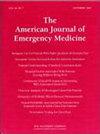急诊科进行子宫肌瘤切除术后出现肠穿孔。
IF 2.2
3区 医学
Q1 EMERGENCY MEDICINE
引用次数: 0
摘要
背景:腹痛仍是急诊科(ED)就诊患者的主要主诉。良性病因或急诊病因均可出现类似症状。全面的病史和体格检查对急诊医生来说至关重要,尤其是对担心可能发生肠穿孔的术后患者。宫腔镜子宫肌瘤剔除术是一种切除子宫肌瘤的微创手术技术。妇科手术历来肠穿孔的发生率较低,然而,对于术后疼痛的急诊患者来说,区分正常的术后过程和术后并发症可能具有挑战性:一名 33 岁的女性患者,有肥胖、结肠炎、II 型糖尿病和高血压病史,因当天早些时候接受宫腔镜手术和子宫肌瘤切除术后出现剧烈下腹疼痛而来到急诊科就诊。虽然她的腹部和盆腔计算机断层扫描显示小肠襻轻度扩张,提示为低位小肠梗阻(SBO)或肠炎,但最初的鉴别诊断仍担心是手术并发症。复查时,她发现术前服用抗生素后出现腹泻。入院后,经阴道超声检查发现她的盆腔内有积液,于是进行了诊断性腹腔镜检查。在她的回肠上做了两个肠切口,并成功修复了两个子宫缺损,几天后她康复了,并发症极少:讨论:该患者最初出现腹痛,伴有恶心和呕吐,在接受子宫肌瘤剔除术的宫腔镜检查后,初步诊断为肠炎。由于持续腹痛,急诊科医生将患者收治入院,结果发现她有两处回肠穿孔,疑似子宫穿孔所致。本文章由计算机程序翻译,如有差异,请以英文原文为准。
Perforated bowel following hysteroscopy with myomectomy in the emergency department
Background
Abdominal pain remains a top chief complaint for patients presenting to the emergency department (ED). Benign or emergent etiologies can present similarly. A thorough history and physical examination are critical for emergency physicians, especially for post-operative patients with concerns for a possible bowel perforation. Hysteroscopies with myomectomies are a minimally invasive surgical technique to remove fibroids. Gynecologic procedures historically have a low incidence of bowel perforation, however, in patients with post-operative pain presenting to the ED, distinguishing between a normal post-operative course and a post-operative complication can be challenging.
Case
A 33-year-old female with a history of obesity, colitis, type II diabetes, and hypertension presented to the freestanding ED with complaints of severe lower abdominal following a hysteroscopy with myomectomy earlier that day. The initial differential diagnosis had concern for a surgical complication, although her computed tomography of the abdomen and pelvis revealed mildly dilated loops of small bowel, suggestive of a low-grade small bowel obstruction (SBO) or enteritis. On reassessment, she noted pre-operative diarrhea after taking antibiotics. After admission, a transvaginal ultrasound revealed a collection of fluid in her pelvis prompting a diagnostic laparoscopy. Two enterotomies in her ileum with two uterine defects were successfully repaired, and she recovered several days later with minimal complications.
Discussion
This patient initially presented with abdominal pain associated with nausea and vomiting following a hysteroscopy with myomectomy, where initial testing led to a possible diagnosis of enteritis. Due to her continued abdominal pain, the ED physician admitted the patient, and it was found that she had two ileum perforations from suspected uterine perforations.
求助全文
通过发布文献求助,成功后即可免费获取论文全文。
去求助
来源期刊
CiteScore
6.00
自引率
5.60%
发文量
730
审稿时长
42 days
期刊介绍:
A distinctive blend of practicality and scholarliness makes the American Journal of Emergency Medicine a key source for information on emergency medical care. Covering all activities concerned with emergency medicine, it is the journal to turn to for information to help increase the ability to understand, recognize and treat emergency conditions. Issues contain clinical articles, case reports, review articles, editorials, international notes, book reviews and more.

 求助内容:
求助内容: 应助结果提醒方式:
应助结果提醒方式:


